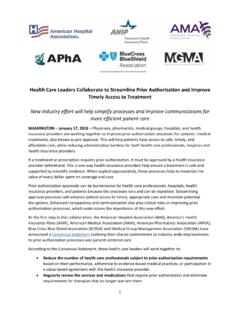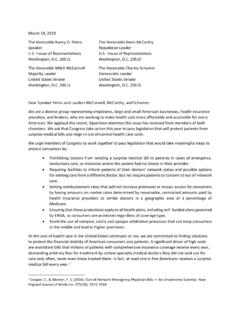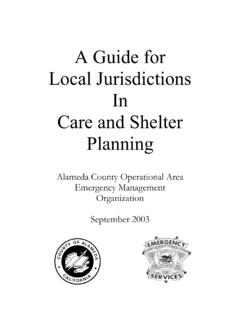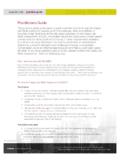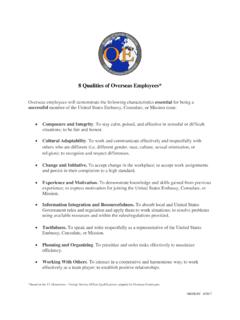Transcription of Access to Healthy Foods: Social Determinants of Health
1 KEY TAKEAWAYS MAY 2018 Access to Healthy Foods: Social Determinants of Health ISSUE BRIEF An estimated 1 in 8 Americans was food insecure in 2016. Food insecure households spend 45 percent more on medical care than people in food-secure households. Successful, sustainable interventions include community- based support with programs that focus on increasing Access and promoting behavior changes related to food preparation. From food delivery services to mobile food pantries, Health insurance providers are investing in innovative models to increase Access to nutritious foods and ultimately, improve Health care outcomes for their members.
2 2 Social Determinants of Health and Access to Healthy Foods | /ahip @ahipcoverage Background A person s Health is influenced by many factors, including housing, education, employment, and Access to Healthy food. These factors, sometimes referred to as the Social Determinants or Social influencers of Health , are defined by the conditions and environment in which people are born, grow, live, work, and age. A lifestyle of Healthy foods and exercise helps prevent the onset of chronic Health conditions. However, millions of Americans have limited Access to foods that promote a Healthy lifestyle.
3 As a result, they are more likely to suffer from chronic conditions, such as hypertension and diabetes1. Limited Access to Healthy food can be driven by different factors: 1. Income, where people are not able to afford food, even though nutritious food may be available close by. 2. Accessibility, where people may be able to afford Healthy food, but it may not be physically available to them ( , people with physical and/or cognitive disabilities, lack of transportation, substandard kitchen not equipped to prepare Healthy foods, etc.) 3. Cultural, where people can afford Healthy food that is geographically accessible, but they need help to learn how to identify and prepare nutritious meals.
4 Market forces can also play an important role, with grocers, restaurant owners, and fast food chains all contributing to the landscape of food availability for communities. For example, the Department of Agriculture defines a food desert as a low-income area where a substantial number of residents has limited Access to a supermarket or a large grocery store2. Recently, experts have also begun citing food swamps, or areas with a high-density of stores selling high-calorie fast foods3, as a similarly quantifiable region where Access to Healthy foods may be limited. As part of their commitment to improve individual and population Health , many insurance providers offer coverage for nutritional counseling, where a registered dietician works directly with patients to improve their dietary intake.
5 However, even with nutritional counselors and patient education efforts, some members may still have difficulty accessing Healthy foods. Facing this challenge, many insurance providers and hospitals have launched initiatives to bring Healthy foods to specific populations of patients who are DEFINITIONS Food Insecurity The uncertain ability to obtain nutritious foods because of Access and/or financial limitations to grocery stores, markets, etc. Food as Medicine Providing medically tailored foods to high-risk patients for prevention and/or treatment of a specific Health care condition ( , a low sodium diet for patients with hypertension).
6 3 Social Determinants of Health and Access to Healthy Foods | /ahip @ahipcoverage chronically ill or face barriers to accessing nutritious foods. Food insecurity initiatives typically focus on the uncertain ability to obtain nutritious foods because of Access and/or financial limitations to grocery stores, markets, etc. Typical interventions may include providing vouchers for families to purchase Healthy foods, developing new models of grocery stores, or providing meal delivery programs. Building on these interventions, food as medicine initiatives programs focus on interventions tailored for high-risk patients for prevention and/or treatment of a specific Health care condition ( , a low sodium diet for patients with hypertension).
7 Research continues to emerge on the effectiveness of these programs. In one study, researchers found that seniors who participated in a medically tailored meal delivery program had fewer emergency department visits, hospital admissions, and emergency transportation trips, compared to those who did not participate. Further, medical spending for those in the medically tailored meal delivery program decreased about $570 per month per person4. Both food insecurity and food as medicine programs have the same goal - increasing patients Access to nutritious foods that promote a Healthy lifestyle.
8 These initiatives work best when community leaders and organizations, doctors and hospitals, insurance providers, and others work together to bring together local resources, support local needs, and work toward having a real impact on local Health . Food Insecurity Resources and Tools Federal, state, and local government stakeholders recognize the impact of food insecurity and have developed strategies to address these issues. Several programs and tools are available to support these efforts: Supplemental Nutrition Assistance Program (SNAP): Administered by the USDA s Food and Nutrition Service (FNS), SNAP offers nutrition assistance to eligible, low-income individuals and families.
9 FNS works through its nationwide network of field offices to monitor those stores participating in SNAP. Food Desert Locater: USDA has a web- based mapping tool to pinpoint the location of food deserts around the country and provide census data to describe population characteristics of residents living in these areas. Women, Infants, and Children (WIC): USDA s Special Supplemental Nutrition Program for WIC provides federal grants to states for nutrition education, supplemental foods, and Health referrals for low-income pregnant, breastfeeding, and non-breastfeeding postpartum women, and to infants and children up to age five who are found to be at nutritional risk.
10 Medicaid Programs: o Medicaid Home and Community- based Waivers (HCBS): HCBS waivers allow states to provide Medicaid services that help those 4 Social Determinants of Health and Access to Healthy Foods | /ahip @ahipcoverage individuals who are at risk of being placed in long-term care facilities stay in their homes. Many states have extended their waivers to include nutrition services ( , home-delivered meals, nutrition counseling, etc.). o Medicaid Managed Long-Term Services and Supports (MLTSS) Programs: Increasingly, states are using MLTSS programs to expand beneficiary Access to HCBS.


